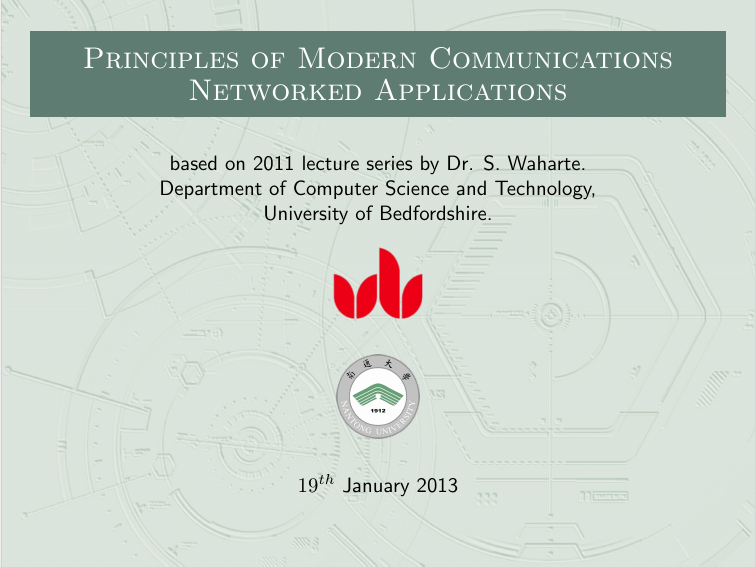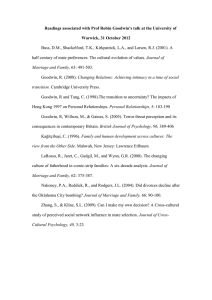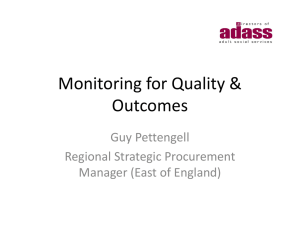Principles of Modern Communications Networked Applications
advertisement

Principles of Modern Communications Networked Applications based on 2011 lecture series by Dr. S. Waharte. Department of Computer Science and Technology, University of Bedfordshire. 19th January 2013 Outline Modern Communications David Goodwin University of Bedfordshire 80 Introduction Modern Communications David Goodwin University of Bedfordshire Networked Applications Applications that require a network to function, such as e-mail and the World Wide Web Application Architectures 80 Where the processing is done Terminal-Host processing Client/Server processing Cloud computing Service-Oriented Architectures (SOAs) Peer-to-peer (P2P) computing Multiprotocol Label Switching (MPLS) Modern Communications David Goodwin University of Bedfordshire Implementing MPLS is difficult. Many individual ISPs and corporations to it. Some individual ISPs have “peering” arrangements with other individual ISPs to do it. There is no general way to move MPLS out to all ISPs and organizations. 80 Introduction Modern Communications David Goodwin University of Bedfordshire Application Architectures Critical to network design The newest architectures involve communication between multiple transmissions between multiple machines. Driven primarily by growing desktop processing power Ever-increasing role for PC processing, storage, and network connection speeds 80 Simple Terminal–Host System Modern Communications David Goodwin University of Bedfordshire 80 Client/Server Computing Modern Communications David Goodwin University of Bedfordshire 80 Client/Server Computing Modern Communications David Goodwin University of Bedfordshire 80 Web-Enabled Application (E-Mail) Modern Communications David Goodwin University of Bedfordshire 80 E-Mail Modern Communications David Goodwin University of Bedfordshire Importance of E-Mail Universal service on the Internet Attachments deliver files 80 E-Mail Standards Modern Communications David Goodwin University of Bedfordshire 80 E-Mail Standards Modern Communications David Goodwin University of Bedfordshire 80 E-Mail Standards Modern Communications David Goodwin University of Bedfordshire 80 E-Mail Standards Modern Communications David Goodwin University of Bedfordshire Many applications have two types of standards. Delivery standards SMTP, POP, IMAP Message format standards RFC 822/2822, HTML, UNICODE It does no good to deliver messages if the receiver cannot understand them. 80 Web-Based E-Mail Modern Communications David Goodwin University of Bedfordshire Either or both clients can use web-based e-mail instead of SMTP and POP or IMAP. All interactions for that client take place via HTTP instead. Message documents are HTML-based. 80 Interactions in SMTP Modern Communications David Goodwin University of Bedfordshire A complex step-by-step protocol Initial Steps The sender sets up a TCP connection. The receiver indicates that it is willing to communicate. The sender identifies itself, and the receiver responds, indicating willingness to proceed (or not). 80 Interactions in SMTP Modern Communications David Goodwin University of Bedfordshire Sending a Message The sender indicates that it has mail to send. Receiver gives permission. Sender indicates the author. Receiver gives permission to continue. For each addressee The sender indicates the addressee on the receiving mail server. Receiving mail server accepts or rejects each. 80 Interactions in SMTP Modern Communications David Goodwin University of Bedfordshire Sending a Message The sender indicates that it has data to send (the body). The receiver grants permission. The sender sends the body, ending with a blank line to indicate that the body is finished. The receiver indicates acceptance. 80 Interactions in SMTP Modern Communications David Goodwin University of Bedfordshire Final Steps The sender sends a QUIT message. The receiver indicates that the transaction is ended. 80 E-Mail Modern Communications David Goodwin University of Bedfordshire Viruses, Worms, and Trojan Horses Widespread problems; often delivered through e-mail attachments Use of antivirus software is almost universal, but ineffective, given the number of malware infections. “Antivirus” programs are not limited to viruses. They scan for many types of malware. 80 Scanning Locations for E-Mail Modern Communications David Goodwin University of Bedfordshire 80 E-Mail Modern Communications David Goodwin University of Bedfordshire Spam Unsolicited commercial e-mail Why filter? 80 Potential sexual harassment suits Time consumed by users deleting spam Bandwidth consumed Time consumed by networking staff deleting spam E-Mail Modern Communications David Goodwin University of Bedfordshire Spam Separating spam from legitimate messages is very difficult Many spam messages are allowed through to users Some legitimate messages are deleted Some firms merely mark messages as probable spam 80 Voice over IP (VoIP) Modern Communications David Goodwin University of Bedfordshire VoIP Sending voice over IP networks. Codec converts voice to a bit stream. Codec reduces the traffic generated to reduce network loads. Packet switching is more efficient than circuit switching. 80 Voice over IP (VoIP) Modern Communications David Goodwin University of Bedfordshire 80 HTTP and HTML Modern Communications David Goodwin University of Bedfordshire 80 Downloading a Complex Webpage Modern Communications David Goodwin University of Bedfordshire 80 Downloading a Complex Webpage Modern Communications David Goodwin University of Bedfordshire 80 Downloading a Complex Webpage Modern Communications David Goodwin University of Bedfordshire Question: How many files will a browser have to download if the webpage has three graphics? 80 Examples of HTTP Request and Response Messages Modern Communications David Goodwin University of Bedfordshire HTTP Request Message GET /panko/home.htm HTTP/5[CRLF] Host: voyager.shidler.hawaii.edu[CRLF] Note: 80 GET is the method. It asks for a file. /panko/home.htm is the path to the file. The browser speaks HTTP version 5. CRLF means “carriage return/line feed.” It means to start a new line. Examples of HTTP Request and Response Messages Modern Communications David Goodwin University of Bedfordshire HTTP Response Message: 80 HTTP/5 200 OK[CRLF] Date: Tuesday, 20-MAR-2011 18:32:15 GMT[CRLF] Server: name of server software[CRLF] MIME-version: 1.0[CRLF] Content-type: text/plain[CRLF] .[CRLF] File to be downloaded. A string of bits that may be text, graphics, sound, video, or other content. Examples of HTTP Request and Response Messages Modern Communications David Goodwin University of Bedfordshire Note that most fields (lines) have a variable name, a colon, and then the value of the variable. Example: MIME-version: 1.0[CRLF] MIME is a standard for describing file contents. The browser speaks MIME version 1.0. This is like e-mail headers with To:, From:, and other fields 80 Cloud Computing Modern Communications David Goodwin University of Bedfordshire A Shared Project 80 Google Docs Shea and Melinda can share documents. Before, they had used e-mail attachments. There was often confusion over who had the most recent version. Cloud Computing: Software as a Service (SaaS) Modern Communications David Goodwin University of Bedfordshire 80 Cloud Computing: Software as a Service (SaaS) Modern Communications David Goodwin University of Bedfordshire 80 Cloud Computing Modern Communications David Goodwin University of Bedfordshire Cloud Computing For users, showing the network as a cloud indicates that they do not have to understand it. In cloud computing, there is a second cloud—a cloud service provider. In cloud computing, the company outsources some combination of servers, server applications, and client PC software to a cloud service provider. If client PC software is outsourced, the client PC only needs a browser. Google Docs is a cloud provider of Software as a Service. Usually metered service—pay as you go. 80 Cloud Computing Modern Communications David Goodwin University of Bedfordshire Software as a Service In Software as a Service (SaaS), an application service provider (ASP) supplies an application to customers on demand. In cloud SaaS, the user typically has a browser only. The application and data are downloaded to the client PC as needed. With cloud SaaS today, there is a broad range of applications available. 80 Cloud Computing Modern Communications David Goodwin University of Bedfordshire SaaS Attractions of SaaS Reduces cost and risk because user only pays for software as needed Saves money because company does not have to manage the application Mobility—users can access the software wherever there is Internet access Collaboration: sharing is easy 80 Cloud Computing Modern Communications David Goodwin University of Bedfordshire SaaS Issues with SaaS If there is no Internet access, the application is unusable. The cloud SaaS provider may go out of business. Loss of control: may be locked into proprietary vendor software. 80 Cloud Computing Modern Communications David Goodwin University of Bedfordshire SaaS Issues with SaaS Security: will company’s data be vulnerable if cloud service provider is attacked or has software vulnerabilities? Legal complications: if user company is required by law to be secure, how can this be satisfied with SaaS? 80 Cloud Computing Modern Communications David Goodwin University of Bedfordshire Cloud Utility Computing In traditional utility computing, a company offloads server processing work to another company at a remote site. In cloud utility computing, the company that receives this processing job is a cloud service provider, and the data is sent over the Internet to be processed. Unlike in SaaS, the application is not managed by the cloud provider—only processing power and storage. 80 Cloud Utility Computing Modern Communications David Goodwin University of Bedfordshire 80 Cloud Computing Modern Communications David Goodwin University of Bedfordshire Cloud Utility Computing Attractions Saved cost and risk of long-term investment No need to hire staff No need to purchase and manage servers 80 Cloud Computing Modern Communications David Goodwin University of Bedfordshire Cloud Utility Computing Attractions Flexibility—can get extra capacity quickly when needed for a short period of time Scalability—will not outgrow the service provider’s capacity 80 Cloud Computing Modern Communications David Goodwin University of Bedfordshire Cloud Utility Computing Issues As in cloud SaaS, loss of control and legal and security concerns 80 Cloud Computing Modern Communications David Goodwin University of Bedfordshire Why is Cloud Utility a Hot Topic Now? The Internet is now fast, reliable, and accessible nearly everywhere Web services (discussed later) Virtualization (discussed later) 80 Cloud Computing Modern Communications David Goodwin University of Bedfordshire Managing Cloud Computing 80 Many advantages Loss of control Must consider security Must have Service Level Agreements (SLAs) for performance Virtualization Modern Communications David Goodwin University of Bedfordshire 80 Virtualization Modern Communications David Goodwin University of Bedfordshire 80 Service-Oriented Architectures Modern Communications David Goodwin University of Bedfordshire Service-Oriented Architectures (SOAs) Traditionally, in client/server computing, a single client program calls a single server program. In service-oriented architectures, a client program may contact many small service objects on many different machines to do the work the client needs. In addition, a service object may serve many clients. Service objects usually do small chunks of work, like computing a currency exchange rate. 80 Service-Oriented Architectures Modern Communications David Goodwin University of Bedfordshire 80 Service-Oriented Architectures (SOA) Modern Communications David Goodwin University of Bedfordshire 80 Service-Oriented Architectures (SOA) Modern Communications David Goodwin University of Bedfordshire 80 Service-Oriented Architectures (SOA) Modern Communications David Goodwin University of Bedfordshire 80 SOA versus Web Services Modern Communications David Goodwin University of Bedfordshire 80 SOA versus Web Services Modern Communications David Goodwin University of Bedfordshire 80 SOA versus Web Services Modern Communications David Goodwin University of Bedfordshire 80 SOAP Messages Modern Communications David Goodwin University of Bedfordshire SOAP is a common way to format requests for services and responses. Simple Object Access Protocol Quite simply, a general way to access (use) service objects Specifically, SOAP standardizes the syntax of request and response message syntax and semantics in SOA interactions. 80 Peer-to-Peer (P2P) Architectures Modern Communications David Goodwin University of Bedfordshire Clients provide services to other clients. Servers are not used or are used only for secondary tasks such as helping a client find another client. Made possible by growing desktop processing power Terminal-Host: no desktop processing power Client/server: some desktop processing power P2P: extensive desktop processing power 80 Traditional Client/Server Application Modern Communications David Goodwin University of Bedfordshire 80 Simple Peer-to-Peer (P2P) Application Modern Communications David Goodwin University of Bedfordshire 80 Traditional Client/Server File Retrieval Modern Communications David Goodwin University of Bedfordshire 80 P2P File Sharing Modern Communications David Goodwin University of Bedfordshire 80 BitTorrent Protocol for P2P File Sharing Modern Communications David Goodwin University of Bedfordshire 80 BitTorrent Protocol for P2P File Sharing Modern Communications David Goodwin University of Bedfordshire 80 BitTorrent Protocol for P2P File Sharing Modern Communications David Goodwin University of Bedfordshire 80 BitTorrent Protocol for P2P File Sharing Modern Communications David Goodwin University of Bedfordshire 80 BitTorrent Protocol for P2P File Sharing Modern Communications David Goodwin University of Bedfordshire Question: What do you think is the advantage of downloading the file from multiple sources instead of a single source? 80 Skype Modern Communications David Goodwin University of Bedfordshire Description and Main Features 80 P2P VoIP service Very popular due to low costs Free calling among Skype customers (computer-to-computer) Reduced-cost calling to and from Public Switched Telephone Network customers Skype Modern Communications David Goodwin University of Bedfordshire How Skype Works Skype Network Skype login server: the only centralized component in the Skype network Host node: a Skype application that runs on a user’s computer Super node: a host node that takes on the work of signaling 80 Skype Modern Communications David Goodwin University of Bedfordshire How Skype Works Three steps for user to place a call 1 Login: the Skype login server authenticates username and password, notes IP address. 2 Signaling/Directory Search: Skype application looks up the username and IP address of the party it wants to contact, using supernodes. 3 Transport: handled by host nodes. 80 Skype Modern Communications David Goodwin University of Bedfordshire How Skype Works Doing signaling and transport by peers rather than going through central server reduces Skype’s operational costs Results in low-cost calls 80 Skype Network Operation Modern Communications David Goodwin University of Bedfordshire 80 Skype Network Operation Modern Communications David Goodwin University of Bedfordshire 80 Skype Network Operation Modern Communications David Goodwin University of Bedfordshire 80 Skype Modern Communications David Goodwin University of Bedfordshire Skype Security Many corporations ban use of Skype because: Skype’s proprietary software and protocols are not revealed to security professionals, change frequently. Detailed method of Skype encryption is unknown. 80 Skype Modern Communications David Goodwin University of Bedfordshire Skype Security Many corporations ban use of Skype because: Registration is open and uncontrolled, so usernames mean nothing from a security standpoint. Skype is almost impossible to control at firewalls. Skype’s file transfer mechanism does not work with most antivirus products. 80 Skype v Traditional VoIP Modern Communications David Goodwin University of Bedfordshire 80 SETI@home Processor Sharing Modern Communications David Goodwin University of Bedfordshire 80 P2P in Perspective Modern Communications David Goodwin University of Bedfordshire Made possible by growing desktop processing power on PCs Types File sharing Communication Processor sharing Potential cost savings by using idle PC resources Management and security issues 80




